WordPress şifrenizi sıfırlamak genellikle basit bir işlemdir. Ancak bazen standart yöntemler işe yaramaz ve sizi web sitenizin dışında bırakır.
Bazı okuyucularımız bu sorunla karşılaştı ve hesaplarına erişmenin en iyi yolu hakkında tavsiyelerimizi sordu. Neyse ki hosting hesabınızın kontrol panelindeki phpMyAdmin aracını kullanarak şifrenizi doğrudan WordPress veritabanından sıfırlayabilirsiniz.
Bu makalede, phpMyAdmin’den bir WordPress şifresini nasıl kolayca sıfırlayacağınızı göstereceğiz. Her adımı net bir şekilde açıklayarak, veritabanlarına aşina olmasanız bile güvenle takip edebilmenizi sağlayacağız.
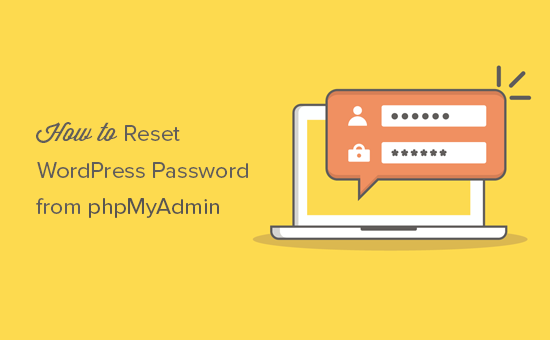
Neden phpMyAdmin’den WordPress Parolasını Sıfırlayalım?
WordPress, kaybolan bir parolayı kurtarmayı çok kolay hale getirir.
WordPress web sitenizin giriş ekranına gidebilir ve “Şifrenizi mi kaybettiniz?” bağlantısına tıklayabilirsiniz.
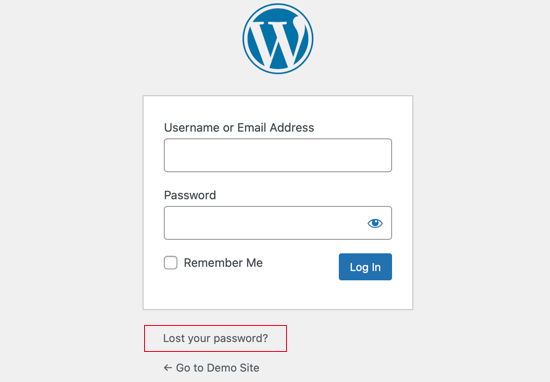
Bağlantıya tıkladığınızda parola sıfırlama sayfasına yönlendirilirsiniz. Kullanıcı adınızı veya e-posta adresinizi girdiğinizde, WordPress ilgili e-posta adresine bir şifre sıfırlama bağlantısı gönderecektir.
Ancak, bu e-posta adresine erişiminiz yoksa veya WordPress siteniz bir e-posta gönderemiyorsa, şifrenizi sıfırlayamazsınız.
Böyle bir durumda, WordPress şifrenizi doğrudan veritabanında sıfırlamanız gerekecektir. Bunu yapmanın en kolay yolu phpMyAdmin kullanmaktır.
Bunu söyledikten sonra, phpMyAdmin’den bir WordPress şifresini nasıl kolayca sıfırlayabileceğinizi görelim.
phpMyAdmin’den WordPress Parolası Nasıl Sıfırlanır
Video eğitimini izlemek istemiyorsanız, aşağıdaki metin versiyonunu okumaya devam edebilirsiniz.
İlk olarak, WordPress hosting hesabınızın cPanel panosuna giriş yapmanız gerekir. Ardından, phpMyAdmin simgesine tıklayabileceğiniz Veritabanları bölümüne gitmeniz gerekir.
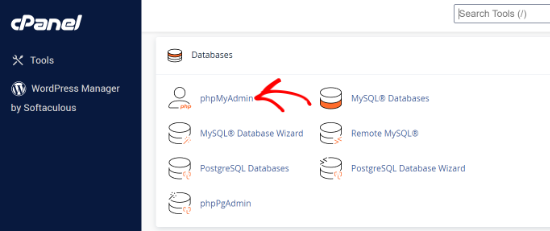
Bu phpMyAdmin uygulamasını başlatacaktır.
Burada sol bölmeden WordPress veritabanınızı seçmeniz gerekir.
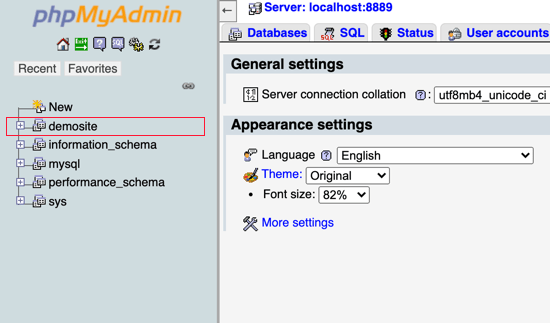
Şimdi WordPress veritabanınızdaki tabloların listesini göreceksiniz.
Bu listede wp_users tablosunu bulmanız ve yanındaki ‘Gözat’ bağlantısına tıklamanız gerekir.
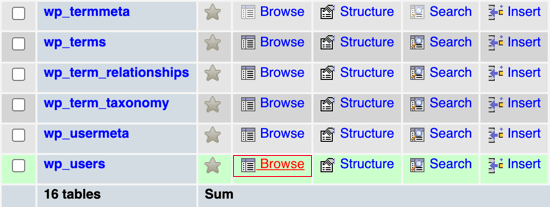
Not: WordPress veritabanınızdaki tablo adları, ekran görüntümüzde gösterdiğimizden farklı bir ön eke sahip olabilir. Tablo öneklerini değiştirmek WordPress sitenizin güvenliğini artırabilir.
Şimdi WordPress kullanıcılar tablonuzdaki satırları göreceksiniz. Devam edin ve şifresini değiştirmek istediğiniz kullanıcı adının yanındaki düzenle düğmesine tıklayın.
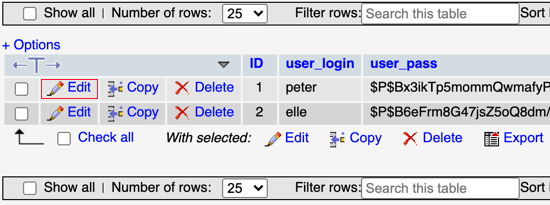
PhpMyAdmin size tüm kullanıcı bilgi alanlarını içeren bir form gösterecektir.
user_pass alanındaki değeri silmeniz ve yeni parolanızla değiştirmeniz gerekecektir. İşlev sütununun altında, açılır menüden MD5’i seçin ve ardından formun altındaki Git düğmesine tıklayın.
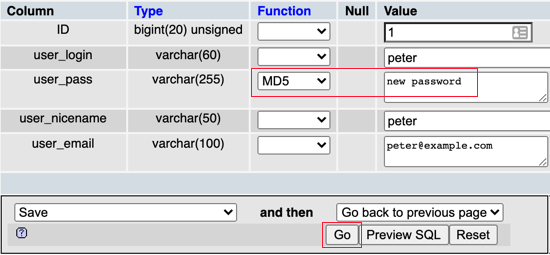
Parolanız MD5 hash kullanılarak şifrelenecek ve ardından veritabanında saklanacaktır.
Tebrikler! phpMyAdmin kullanarak WordPress şifrenizi başarıyla değiştirdiniz.
Bazılarınız parolayı şifrelemek için neden MD5 karmasını seçtiğimizi merak ediyor olabilir. WordPress daha önce şifreleri şifrelemek için MD5 hash kullanıyordu, ancak WordPress 2.5’ten beri daha güçlü şifreleme teknolojileri kullanıyor.
Bununla birlikte, WordPress geriye dönük uyumluluk sağlamak için MD5’i hala tanımaktadır. MD5 karması olarak saklanan bir parola dizesi kullanarak oturum açar açmaz, WordPress otomatik olarak bunu daha yeni şifreleme algoritmalarını kullanacak şekilde değiştirecektir.
WordPress’te Şifreler Hakkında Uzman Kılavuzları
Artık phpMyAdmin’den bir WordPress parolasını nasıl sıfırlayacağınızı bildiğinize göre, WordPress’teki parolalarla ilgili diğer bazı makaleleri görmek isteyebilirsiniz.
- WordPress’te Şifrenizi Nasıl Değiştirirsiniz (Başlangıç Kılavuzu)
- WordPress’te Tüm Kullanıcıların Parolaları Nasıl Sıfırlanır
- WordPress Parola Sıfırlama Sayfası Nasıl Özelleştirilir
- WordPress’te Kullanıcıları Parola Değiştirmeye Zorlama – Expire Password
- Şifrenizi mi Unuttunuz? WordPress’te Kayıp Parola Nasıl Kurtarılır
- WordPress’te Kullanıcıları Güçlü Parolalara Zorlama
- WordPress’te İki Faktörlü Kimlik Doğrulama Nasıl Eklenir (Ücretsiz Yöntem)
- WordPress Giriş Ekranında Kullanıcıların Parolaları Gizlemesine/Göstermesine Nasıl İzin Verilir?
- Parolalar Nasıl Kolayca ve Güvenli Bir Şekilde Yönetilir (Başlangıç Rehberi)
Umarız bu eğitim phpMyAdmin’den WordPress şifresini sıfırlamayı öğrenmenize yardımcı olmuştur. WordPress sitenizi güvende tutmak için adım adım WordPress güvenlik rehberimizi veya olmazsa olmaz eklentiler uzman seçimimizi de görmek isteyebilirsiniz.
If you liked this article, then please subscribe to our YouTube Channel for WordPress video tutorials. You can also find us on Twitter and Facebook.





Bowen
Hello,
Added Https to all pages, says unsafe, attempt to login and no luck, hit forgot password system reverts to Mojo Page…changed password per instructions above still no luck…any ideas how to get https off wordpress?
Tess
OK, I have followed these instructions and successfully changed my admin password in the database and I still get a failed login message when I login with it. I need help gaining access to my site, please.
Sandra
Thank you so much! These instructions helped me reset my WP username and password
neotanvir
How can I transfer MD5 to normal text
Patty Ayers
Thank you! Worked like a charm.
Edwin Schichter
Very simpel…. just change and save the users emailadress into something familiar in the database, click on forgot password in the wordpress login page
Patty Ayers
Yes, but only if you already have access to the back end.
Andrew
Awesome thanks so much for taking the time to write this just recovered by site in 60 seconds – as a newbie rely on help online :)))
Yana
Thanks mate, you made my day =)
Kinfe Weldu
thank you.this solved my problem.
sarah
thanks very helpful
Toyin
Thanks for this article.Simple guide,was able to change my password through myphp.
harish chand
Great thanks
MITESH MISTRI
Hey… Nice post and this idea really works. Thanks.
Adeel Ahmed
Thanks a lot. I had the problem but it has been solved . Otherwise I felt miserable about my wordpress login password being stolen
Jedediah
Odd, I did this correctly and it’s still not letting me in.
venukanth
really thanke ..most use full
Hasan
Thanks, it’s really helpful and great !!
Razzaq
another simple method for get the password, after edit the record change the email address. On wp-admin login screen, click on forget password. You will get the new link of make a new password.
Harsh
Thanks a lot friend, very helpful post
Asaf Fialkov
Many thanks! Worked like a charm
Mike
Fantastic, you are geniuses!
Ken
Thanks Man, your a lifesaver
Dave
Perfect. Thanks for posting.
VaLAngel
Great, great, great! 1 Billion Thanks…
Clinton
Thank you!
Al
Thanks buddy, i used to do lots of stuff on my wordress blog few years ago but now i kind of forget how to do it. Your blog post refreshed my memory…thanks again
Jarrii
Thank you so much It works perfectly
It works perfectly 
Hilda
worked perfectly, thank you so much!
Dan
Followed your very clear steps. Worked like a charm. THANK YOU!
Rose
Thank you so much! I couldn’t get into my new install of Word Press and of course it is the weekend. This is so well written that I was able to reset the admin password in one try.
Ewan
How is this discussion affected by the salts in the wp-config file? Do we need to combine those when creating a new password?
Marty
Over the last few weeks, I’ve had the pleasure of dealing with clients that didn’t have a reputable developer/designer and left them high and dry with little to no access of their OWN site, noway of re-setting the password through the recovery email, this guide WOULD have been great 2 weeks ago, but I’m sure I’ll be using it in the near future…
cheers Syed..
Karl Craig-West
Perfect, worked a treat.
Many thanks indeed.
Harpa
Thank you so much
Dotty
Thanks so much – this really helped.
Luis
What a lifesaver post! Thanks!
Ton
Thank you so very much!
Andrea
ok, I have done step by step everything you have suggested and is not working……..what can I do?
Editorial Staff
Theoretically, if you did everything mentioned in this article, then it should work. However, you can always try this tutorial where you add a new admin user.
https://www.wpbeginner.com/wp-tutorials/how-to-add-an-admin-user-to-the-wordpress-database-via-mysql/
Admin
Marty
You can lead a horse to water………..but…..!…..
BK
This was a life save. thanks
vking
thanks you man it’s work!
it’s work!
Muhammad Abdul Qadoos
why not we change email address and ask wp to resend password reset email
we change email address and ask wp to resend password reset email 
Editorial Staff
You can do that as well. Then go click on reset button. Wait for the email to come. Then reset your password. Seems like a bit longer process, but to each their own.
Admin
subbareddy
this helps very much when you are in local system . Password reset doesnt work some times in local server .
I helped me a lot today
Benjamin
Some hosts have the mail() function turned off and are unable to send emails via php.
stevelockridge
Fabulous!!! Thank you!!! My client contacted me because their previous designer vanished and left them with NO login information for ANYTHING. This saved us all a lot of headaches.
rradvani
great saved me !!! thanks wpbeginner!!
!!! thanks wpbeginner!!
sharphue
See that user_email field in the screenshot above? Just change the value to an e-mail address that you have access to. On the WP-Admin login screen, click “lost your password?” and type in the same e-mail address and you will receive a reset password link that will be easier than messing with MD5 hashing.
Oluniyi D. Ajao
Thank you very much. You saved me having to re-install a WordPress installation.
W^L+
There has been some talk about web applications moving to a hash of the password + another string, to make it harder for bad guys to get in. Do you think this is coming to WP soon? (I think Joomla and Drupal are already doing this.)
Editorial Staff
WordPress already has that built-in. You just have to add your own security keys in your wp-config.php file. Open it and you will see the place for it and a link where you can get your security keys from.
Admin
Jeff
Under the functions column, if you choose MD5, MySQl will automatically encrypt your password in MD5. Simply type your plaintext password in the main box.
This is a little easier than using other sites.
kusanagi
very helpful, thanks.
Utkarsh
You can also enter the password in plain text, and select MD5 from the function dropdown. It’ll automatically save the MD5 hash of the password in the database.
Jaspal
Thnx .. that’s a great tip .. it will be very helpful for me